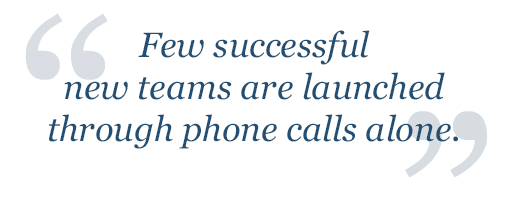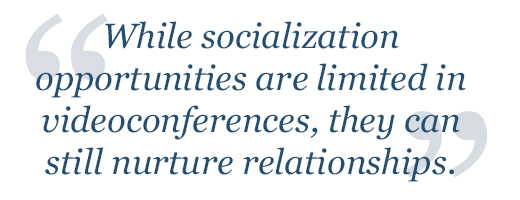You need a meeting to advance your program, but time, space, and money are obstacles. The experts you need are spread across 3 different sites separated by 6 time zones. Schedules and travel funds are so tight that face-to-face consultation needs to be postponed until truly necessary. Might virtual connection be a viable option?
The remote connection quandary is increasingly common in drug development and marketing. Tight timelines, slashed budgets, and new regulations challenge in-person assemblage. At the same time, technological advances and greater bandwidth have dramatically increased the potential value of virtual contact.
But to maximize the opportunity instead of paying a high price for poor planning, the specific type of virtual meeting must be carefully matched to its purpose. To determine when a virtual meeting offers the right virtues, carefully consider the relative merits of teleconferencing, videoconferencing, and increasingly powerful multimodal platforms.
The principal advantage of teleconferencing is simplicity. Meetings cost little and can be called at the drop of a hat, hats worn almost any place in the world. (This advantage can quickly become a hindrance when participants must connect on clattering trains or in airports amidst relentless flight announcements.)
Simplicity extends to stability, since teleconnections are relatively stable compared with more finicky videoconferences.
Yet if teleconnections are easily established, they are quickly undone when used for the wrong meeting purpose. Teleconferencing is unimodal, depending only on sound, while much communication occurs through sight – through nonverbal gestures, expressions, and body language. When participants give up so much of the information they typically rely on in interpersonal discourse, the potential for confusion, conflict, and mere distraction (e.g., multitasking or daydreaming) increases. Teleconferencing should not be used when these risks are significant.
Don't use teleconferencing when trust and mutual familiarity are low; confusion about motives or even meaning will likely lead to conflict. Few successful new teams are launched through phone calls alone, though many prosper telephonically after richer meeting types establish relationships and trust.
Do consider teleconferencing to share information and positive or neutral news. For instance, filing teams often employ daily teleconferences to update global participants on status, make tactical decisions, and identify emerging issues. Yet they agree to reconvene in other meetings types if solutions will be complex or controversial. Similarly, global departments might use a phone meeting for Q&A to field questions about information all have received through other channels.
Do plan to use teleconferencing as a backup plan for any other meeting type when technological hiccups—or missed travel connections—undo more effective meeting formats. Always have a backup that can be implemented quickly for each individual meeting element.
Unfortunately, in the pharmaceutical world, meeting mode is not always a matter of choice. Not infrequently, sponsors request face-to-face consultation with a health authority but are offered a teleconference only. When this happens, special planning is needed to manage the informationally impoverished medium, such as checking for clarity and comprehension.

Yet the limitations of teleconferencing can liberate, too. Teleconferences are the one regulatory setting in which unannounced participants can attend invisibly and so offer a rare opportunity for the full team to attend a pre-IND meeting as auditors. Similarly, muting allows regulators to huddle on their side during labeling negotiations and make timely decisions without needing to defer to another meeting. Bear in mind, though, that the wise team never trusts that muting on their side will always silence conversation.
Because videoconferences join sight with sound, they more closely approximate the complexity of face-to-face communication. Telepresence, with its high resolution and illusion of shared space, provides an even closer approximation. (Not always an advantage, of course, as when bleary-eyed Americans in pajamas need to join morning meetings in Europe.)
Yet they are often a better option for virtual meetings beyond the scope of teleconferencing. They double the approximate one-hour limit for effective phone meetings. They enable more complex discussions than participants can sustain through vocal engagement alone.
Videoconferences are better suited for negotiations and for allowing a leader to gauge the engagement of his or her team. Moreover, they can successfully be employed to overcome strategic or scientific differences and even for directly addressing the feelings such differences evoke. Overall, they are the preferred alternative for any sensitive discussion in which nonverbal signals must be monitored.
While socialization opportunities are limited in videoconferences, they can still nurture relationships. Global teams have celebrated milestone achievements by sharing virtual champagne toasts in this setting. And many companies have at least experimented with videoconferencing as a less expensive option for investigator meetings. To increase interaction—and bonds—between and among sponsor and investigators, hybrid strategies can be used, such as inviting neighboring investigators to common VC sites, where a team member will join them, along with catering and all needed materials.
For more collaborative virtual meetings, videoconferencing should be enhanced with technology that allows real-time document sharing and manipulation as well as shared whiteboards. Many office-based facilities have built in such capabilities. For webconferencing in other settings, the most common advanced meeting platforms include AdobeConnect, WebEx and GoToMeeting. These platforms require only a computer and internet access.
These platforms are effective not only for reviewing documents and making real-time revisions but for initial document design. Teams have effectively used shared whiteboards to brainstorm messages, issues and responses, and even to collaboratively develop target profiles or visuals. Face-to-face teams sometimes put ideas on yellow "stickies" and cluster them on the wall; virtual teams can do the same.

A multimodal meeting can be an effective precursor to a face-to-face meeting when time or funding is limited. For instance, one group of regional monitors identified, prioritized, and proposed solutions to the most significant problems they had encountered across investigational sites. They then met face-to-face with a small subgroup and the project core team to consider protocol revisions.
When Virtual Meetings Lack Required Virtues
While remote connections can provide effective alternatives for many targeted meeting purposes, they miss the mark and, worse, risk collateral damage when used at the incorrect time or situation. The time and cost of face-to-face communication seem merited when:
- Participants have not previously met and established trust
- Participants have met but subsequently lost trust
- Teams need to address and manage controversial or high-stakes issues
- Teams need to collaborate under pressure
- Teams need to collaborate for sustained periods, such as full days when meetings cannot be staggered throughout a week
Like almost everything in the pharmaceutical industry, the choice of meeting mode comes down to Benefit/Risk. Know both, weigh each, and select the one that promises greater effectiveness given the constraints of time, space, schedules, and cost.





